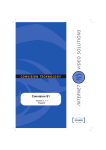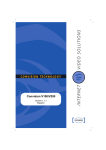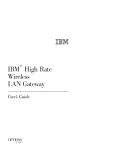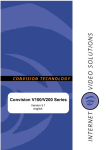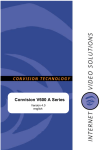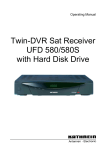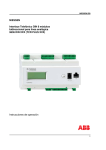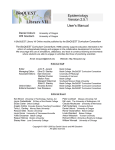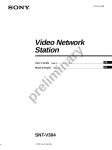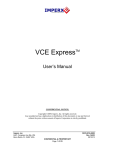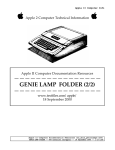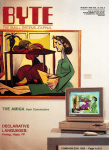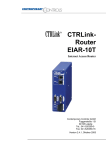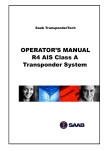Download CONVISION TECHNOLOGY
Transcript
CONVISION TECHNOLOGY
Convision S1
Version 1.1.1
English
Convision S1 Manual
Version 1.1.1
March 2001
© Convision Technology GmbH
All rights reserved
No part of this manual may be reproduced or transmitted in any form without
the prior written permission of Convision Technology GmbH.
All information and descriptions have been compiled with great care on the
basis of thorough research. However, we cannot provide a complete guarantee
that there are no errors or changes to applications which may result in different
operational sequences or other consequences. Convision Technology GmbH
can accept neither responsibility nor legal liability for any consequences arising
from this or from unintentional errors.
Convision and Convision S1 are trademarks of Convision Technology GmbH.
Microsoft, MS Windows NT, MS Windows 95, MS Windows 98, MS
Internet Explorerare trademarks or registered trademarks of Microsoft
Corporation. Netscape and Netscape Navigator are registered trademarks
of Netscape Communications Corporation. All other trade names and product
names are the trademarks or registered trademarks of the respective owners.
Convision Technology GmbH cannot accept liability for increased telephone
costs, including costs arising from accidental telephone connections.
Convision Technology GmbH has developed this manual to the best of its
ability, but can provide no assurance that the programs / systems will fulfil the
purpose anticipated by the user.
Convision Technology GmbH reserves the right to modify the content of the
User Manual without accepting responsibility for informing third parties.
We reserve the right to make technical modifications.
Convision S1 - Manual
1
General
Congratulations on purchasing the Convision S1.
This manual is intended to provide you with the knowledge required to connect
and operate the Convision S1. Also included in the appendix are the principles
for installing the required software onto your computer, if not already installed.
No additional software is required to operate the Convision S1, all components
are normally included in the basic software package supplied with your
computer.
Please read this manual before connecting your Convision S1.
If you have any difficulties operating your Convision S1, please first check in
the manual to ensure that you have observed all configuration steps. If a
problem cannot be solved after thoroughly checking, you can contact Convision
Technology's support service or your retail dealer.
The latest release of the Convision S1 manual and the Convision S1 firmware
can be downloaded free of charge from the Convision website
(www.convision.de).
The Convision S1 and cameras must only operated using 12V DC
Step by step
1.
Fulfil system requirements – Chapter 3
2.
Connect the components – Chapter 5
3.
Configure your system –Appendix A
4.
Set up your browser – Appendix C
5.
Configure your Convision S1 – Chapters 8 to 11
2
Convision S1 - Manual
Contents:
1
GENERAL INFORMATION .................................6
2
PRODUCT DESCRIPTION .................................7
3
SYSTEM REQUIREMENTS.................................8
3.1
3.2
Hardware Requirements................................................. 8
Software Requirements.................................................. 8
4
CONTROL ELEMENTS, CONNECTIONS AND
INDICATOR LAMPS ..................................9
4.1
4.2
Front View.................................................................... 9
Rear View .................................................................. 10
5
CONNECTING THE CONVISION S1.................. 11
5.1
5.2
5.3
5.4
Connection to the Power Supply....................................
Connection to a LAN ....................................................
Connecting the Camera................................................
Input Connections .......................................................
6
TECHNICAL INTEGRATION............................. 14
6.1
6.2
6.2.1
6.2.2
6.2.3
6.2.4
6.2.5
Direct Connection to Convision S1.................................
Incorporating Images into HTML Pages ..........................
JPEG images - Direct Access to Convision S1 ..................
JPEG Images, FTP Upload.............................................
Motion JPEG Stream ....................................................
MPEG Stream - Direct Access to the Convision S1 ...........
MPEG via Real Server (Multicast Server MCS) .................
7
INITIAL OPERATION OF THE CONVISION S1.... 28
7.1
7.2
7.3
7.4
IP Configuration in a LAN Network.................................
IP Configuration via direct Connection using a CrossConnect Ethernet Cable ...............................................
Initial Operation via the Serial Interface.........................
Delete Configuration....................................................
8
THE MAIN MENU HOMEPAGE ......................... 32
9
CAMERA...................................................... 33
9.1
9.2
9.3
View of a pan tilt Camera ............................................. 33
JPEG ........................................................................ 35
MPEG ........................................................................ 38
Convision S1 - Manual
11
11
12
13
16
17
17
19
21
23
26
28
29
30
31
3
10
APPLICATIONS - DISPLAY ............................. 40
10.1
10.2
10.3
10.4
Real Server................................................................. 40
Frame Buffer - Display ................................................. 41
Sockets ...................................................................... 42
Weather Station .......................................................... 42
11
CONFIGURATION ......................................... 43
11.1
11.1.1
11.1.2
11.1.3
11.2
11.2.1
11.2.2
11.3
11.3.1
11.3.2
11.3.3
11.3.4
11.4
11.4.1
11.4.2
11.5
11.6
11.7
11.8
11.9
11.10
11.11
11.12
Camera ...................................................................... 43
General – Settings for the Image Display........................ 43
Parameters ................................................................. 44
Adjusting the Camera Properties ................................... 45
Applications ................................................................ 46
Equipment – Assignments for the Serial Inputs ............... 46
Real Server................................................................. 48
System Settings .......................................................... 49
Language ................................................................... 49
Setting the Time and Date ............................................ 49
Activating the FTP Server ............................................. 49
Update - Transferring new Software............................... 50
Configuring the Connections ......................................... 52
IP-Addresses............................................................... 52
Mail Server ................................................................. 53
Security Settings ......................................................... 54
Inputs ........................................................................ 55
Configuration of Frame Buffer ....................................... 55
Creating Messages....................................................... 56
Time – time-controlled Sending of Messages ................... 60
Event Log ................................................................... 61
Tips ......................................................................... 61
Information ................................................................ 61
12
GENERAL NOTES.......................................... 62
12.1
12.2
12.3
12.4
12.5
12.5.1
12.5.2
12.5.3
12.5.4
The Convision S1 as a Video Server ............................... 62
Server Push and JAVA Applet ........................................ 62
FTP 62
Control using CGI Parameters ....................................... 62
The TCP/IP – Protocol Group ......................................... 63
The Internet Address ................................................... 63
Structure of an IP Address ............................................ 63
The Domain Name Server (DNS) ................................... 64
Assignment of IP Addresses .......................................... 65
13
TECHNICAL DATA......................................... 67
13.1
Convision S1 ............................................................... 67
4
Convision S1 - Manual
13.2
13.3
13.4
Convision CC1 Camera................................................. 68
Convision CC2 Camera, controllable .............................. 68
Convision CC3 Camera................................................. 69
APPENDIX A
abc-
CONFIGURING THE LAN NETWORK .... 70
Checking IP Addresses in Windows ................................ 70
Setting up the Network (LAN) in Windows NT ................. 71
Setting up the Network (LAN) in Windows 9x.................. 72
APPENDIX B SETTING UP A TERMINAL PROGRAM IN
WINDOWS............................................ 74
APPENDIX C
ab-
SETTING UP THE BROWSER .............. 76
Setting up Netscape Navigator...................................... 76
Setting up Microsoft Internet Explorer ........................... 77
APPENDIX D FAQ – FREQUENTLY ASKED
QUESTIONS.......................................... 79
APPENDIX E
DECLARATION OF CONFORMITY ........ 84
APPENDIX F
TABLE OF FIGURES .......................... 85
APPENDIX G
INDEX ............................................ 87
Convision S1 - Manual
5
1
General Information
Scope of Delivery
After unpacking, check whether all parts are present.
Convision S1
Power supply DC 12 V, 1.5 A
Adapter for BNC to cinch
Cable, mini-DIN-8 to D-Sub-9
Diskette with Convision IPSetup tool
(in the near future on CD)
Manual
A sticker with the unit model and serial number is located on the bottom of the
Convision S1. This information is also given on the HTML pages in the menu
"Info" (see Chapter 11.12). Here you can also see the present software version
for your Convision S1.
Safety Notes
The Convision S1 is a high quality electronic product, please follow the safety
notes below to avoid damage:
Never place Convision S1 in the vicinity of a furnace, heater or
expose to direct radiation from the sun.
Do not cover the Convision S1.
Clean your Convision S1 only with a moist cloth without abrasive
cleaning agents, position your Convision S1 where it is
protected against splashing water.
Never open the Convision S1 yourself. In the event of
malfunctions or defects, please contact the Convision
Technology GmbH support service or your dealer.
Opening the unit invalidates the guarantee!
6
Convision S1 - Manual
2
Product Description
The Convision S1 is an independent video web server for live image
transmission in the Internet or in a local network at a rate of 10 or 100 MBit/s.
Data transfer is accomplished via TCP/IP.
Here, it is possible to select between MPEG or JPEG streaming. The unique
MPEG hardware compression from Convision Technology, which transmits up
to 25 images per second through the worldwide network, guarantees that the
image is always clear. The advantage of MPEG technology is that instead of
transmitting each image separately, only the differences between the individual
images are transmitted. The data quantity is thereby reduced considerably
increasing the number of images which can be transferred.
JPEG streamlining is accomplished with up to eight images per second, if users
have direct access to the Convision S1, the number of access possibilities is
higher than for MPEG, moreover, there is no time delay for reproduction.
Two inputs are available on the Convision S1 for monitoring functions. Here,
motion sensors can be connected, for example. Any desired video camera with
PAL/NTSC composite signal can be connected to the camera connection
depending on the application. A serial interface allows control of pivoting
cameras and other connected equipment.
An integrated image memory, which stores up to 32 prealarm and post-alarm
images in the event of an alarm makes the units ideal for monitoring purposes.
Only an Internet browser is required for viewing the images. All settings
required for installation can also be configured easily with the browser. Thanks
to the Internet compatibility of Convision Technology, the operating system
itself is absolutely insignificant.
Convision S1 - Manual
7
3
3.1
System Requirements
Hardware Requirements
A computer with Ethernet connection is required for installation of the Convision
S1. The Convision S1 is laid out for a 10/100 Mbit/s auto-sensing TP
connection (twisted pair).
Further information on the subject of cabling can be found in Chapter 5.2.
3.2
Software Requirements
In order to be able to configure the Convision S1, an Internet browser which
supports JAVA is required, such as Microsoft Internet Explorer 4.x or Netscape
Communicator 4.x. We recommend using Netscape in order to be able to
display the “image sequences” or moving pictures more quickly.
No special software is required to operate the Convision S1, as all components
are normally already included in the standard software package supplied with
the computer.
On computers with MS operating system, initial installation can be called
directly as an EXE file via Convision IPSetup, with other operating systems,
installation of a "JVM - Java Virtual Machine" is be necessary.
8
Convision S1 - Manual
4
Control Elements, Connections
and Indicator Lamps
The Convision S1 includes various control elements, connections and indicator
lamps which are explained in more detail below.
4.1
Front View
On the front of the Convision S1 there are four indicator lamps which indicate
the status. These include the following:
♦ Cam: This indicator lamp illuminates when a camera is connected to the
Convision S1.
♦ Online: flashes slowly if the Convision S1 is not configured, i.e. it has no IP
♦
♦
adress.
Link/Activity: Illuminates when a connection is present to the Ethernet,
flashes when data is transferred.
Power: Illuminates as soon as the Convision S1 is connected to the line
power and switched on.
Fig. 1: Front view of the Convision S1
Convision S1 - Manual
9
4.2
Rear View
The external connections required for setting up the unit are located on the rear
of the Convision S1. The various connections are described in detail below:
Fig. 2: Rear view of the Convision S1
1.
8.
ETHERNET: 10/100 Base T connection for using the Convision S1 in a
LAN.
POWER OUT: 12V-DC: socket for the power supply for a connected
camera
CAM: BNC Video Connector for the camera
SERIAL: (Mini Din 8) serial interface: used to control external devices, e.g.
swivel camera, weather station etc. Convision provides a list of all available
devices on its website www.convision.de (also see Chapter 10).
M-Switch: For deleting configuration
ON/OFF: pressing this button switches the device on and off.
Input connections: used to connect additional devices, e.g. smoke and
motion detectors. (see Chapter 11.6)
POWER IN: socket for the power supply supplied with the unit
10
Convision S1 - Manual
2.
3.
4.
5.
6.
7.
5
Connecting the Convision S1
5.1
Connection to the Power Supply
Connect the 12V plug of the connection cable from the power supply to the
POWER IN socket on your Convision S1. Connect the power supply to line
power with the power cable. Activate the ON/OFF switch on the rear of the unit.
5.2
Connection to a LAN
In a LAN network, the Convision S1 is connected to your computer via a TP
cable (Twisted Pair). An additional device is required in the network, a hub, also
known as a star distribution board. For this purpose, you require an 8-pin TP
cable with RJ-45 connector.
Ethernet
Hub
Computer
Convision S1
Fig. 3: LAN connection
1.
Connect one end of the TP cable to the Ethernet connection on the rear of
the Convision S1 (see Fig. 2: Rear view of the Convision S1).
2.
Connect the other end of the TP cable to one of the inputs on the hub.
3.
Please see Chapter 11.4 for information on setting the IP addresses.
Convision S1 - Manual
11
☛ Note:If you want to connect the Convision S1 directly to your PC, the two
devices can be connected using what is known as a cross-connect cable.
This is an eight-pin twisted pair cable with crossed pin connections.
(see Chapter 7.2).
5.3
Connecting the Camera
Depending on the application of your Convision S1, it is possible to connect
different FBAS cameras such as an underwater camera or infrared camera.
The following illustration shows connection of the Convision CC3 or CC2.
Fig. 4: Camera connection
Connection of the Convision CC3
1.
To supply the camera with 12V DC, connect the power supply of the
camera to the Power out socket next to the Video connection on the rear.
The camera can also be supplied with power externally by a separate
power supply.
2.
Connect the video output of the camera (BNC connector) to the video input
of theConvision S1.
Connection of the Convision CC2
3.
Connect the camera plug to the video connection (CAM) on the rear of the
Convision S1 using the adapter supplied (BNC to cinch).
4.
Connect control cable (8 pin mini-DIN) to serial input (SERIAL) of
Convision S1.
5.
The power is supplied separately by the power pack included with the
camera.
12
Convision S1 - Manual
5.4
Input Connections
Only components which have been developed for 12 Volt
technology should be connected in the alarm section on the
Convision S1.
230V devices must not be connected to the inputs on the
Convision S1!
Various indicator components can be connected to the inputs. As they react to
a low/high level change, the components must be closed in the idle state (NC
type normally closed, “break contact”).
Strip the cover of about 10-13 mm of cable for the alarm device. Press with a
small screwdriver against the clamping device above the socket and put the
twisted cable into the socket. After releasing the clamping device the cable
secures itself, check it by pulling easily.
Connection of a switch
Type NC (Normally Closed)
break contact
Fig. 5: Example 1 Input Connection
Connection of a magnetic switch
Type NC (Normally Closed)
break contact
Fig. 6: Example 2 Input Connection
Connection of a motion detector
for alarm units
with own power supply
Type NC (Normally Closed)
break contact
Fig. 7: Example 3 Input Connection
Convision S1 - Manual
13
6
Technical Integration
The Convision S1 can be connected in numerous different ways. A summary of
the various connections and different possibilities of incorporating images and
image sequences (videos) into your website is given below.
The individual connections allow various simultaneous access to the Convision
S1. The band width of the various transmission paths, i.e. the quantity of data
which can be transferred simultaneously varies highly. Each type of link is
therefore best suited for certain image transmissions.
Please bear in mind, before decidiing on a possibility, that the speed with which
a visitor sees your site is not only dependent on your Internet connection but on
their Internet connection as well.
Companies often have 1 or 2 MBit/s leased lines to the Internet, however, many
individual users only have an ISDN or modem connection to date. For this
reason, these users have only the possibility of viewing the videos at a
maximum transmission rate of 64 or 128 KBits even when the Convision S1 is
optimally connected.
The MPEG standard describes an image transfer rate of 25 images per second.
In order to ensure this speed over slower transmission paths, the quality of the
video is reduced. A video transferred via ISDN will therefore appear less fluent
than one transferred via LAN.
14
Convision S1 - Manual
The following table provides a summary of the types of links for the Convision
S1, transmission paths and image data described in the following chapters:
Transmission
path
Direct access to
Convision S1 pages
Image
data
direct
Chapter
6.1
JPEG,
M-JPEG
MPEG
Incorporation of images direct
in Web pages
JPEG
6.2.1
M-JPEG
6.2.3
MPEG
6.2.4
FTP-Upload
JPEG
6.2.2
MCS RealServer
MPEG
6.2.5
A schematic drawing is shown below for every type of link. In all drawings the
numbers have the following meanings:
♦ 1 – request for images to Convision S1
♦ 2 – S1 reply to this request.
Pictures with a size of approx. 32 KBytes (best quality, picture size 352 x 288
pixels) are used as a basis for the data transmission rate.
Convision S1 - Manual
15
6.1
Direct Connection to Convision S1
With a direct link, the user has direct access to the Convision S1 with a
computer browser. The HTML pages then appear on the screen and the user
can select between display of JPEG images, motion JPEG or MPEG streams.
Moreover, the user has access to the configuration pages only with a password
where applicable.
RRR Simultaneous access: up to 20, with cross-connect cable 1
Ø Ø Ø Data transmission rate: JPEG up to 8 images per second,
MPEG 25 images per second
Fig. 8: Incorporation into a LAN
The simplest and fastest access possible to the Convision S1 is incorporation
into a LAN using a permanently assigned IP address. The Convision S1 is
integrated into the network using a hub or switch or is connected directly to a
computer using a cross-connect cable. The request (1) goes over the network
directly to the Convision S1, the reply (2) goes directly back to the computer.
☛ Note: Connection of the Convision S1 using a leased line with sufficient
capacity is comparable to connection in a LAN. A leased line with capacity
of 2 MBit supplies the same number of images per second. The connection
to the Internet via a leased line normally goes over a router to an ISP
(Internet Service Provider). For this reason, the systematic layout of the
connection can be better compared with Chapter Fehler! Verweisquelle
konnte nicht gefunden werden., however, provides a higher data transfer
rate depending on the capacity of the line.
16
Convision S1 - Manual
6.2
Incorporating Images into HTML Pages
The Convision S1 offers numerous possibilities for incorporating images or
image sequences into a website. In the following chapters, a distinction is
initially made according to the type of data.
6.2.1
JPEG images - Direct Access to Convision S1
RRR Simultaneous access: up to 20
Ø Ø Ø Data transmission rate: Individual images
Fig. 9: Incorporation of JPEG images into a website directly by Convision
S1
When setting up your website you incorporate a link which completes a
connection to the Convision S1, picks up and displays an image. The image
size (e.g. fullsize) can be predefined. The size of the table cell is adapted.
A connection to the Convision S1 is completed, exactly 1 image is picked up
and then the connection is terminated again.
Example – Direct transmission of JPEG images:
Convision S1 - Manual
17
.....
<TABLE>
<TR>
<TD> <IMG SRC="http://IP-Address_of_S1/fullsize.jpg?"
WIDTH="352" HEIGHT="288" BORDER="0"></TD>
</TR>
</TABLE>
.......
The image ("fullsize") is loaded into a table cell in this example, whose size is
adapted to the image.
☛ Note: If the image is refreshed at extremely short intervals, you can also
use the "Server Push-Applet" or Server Push for the Netscape Navigator
present in the Convision S1 (see also Motion-JPEG). Here, a connection is
completed and remains open as long as new images are being transferred.
18
Convision S1 - Manual
6.2.2
JPEG Images, FTP Upload
RRR Simultaneous access: Depending on provider
Ø Ø Ø Data transmission rate: 1 image per second
Fig. 10: Incorporation of JPEG images into a Website via FTP upload by
Convision S1
You configure the FTP client function for the Convision S1 (see Chapter 11.7),
causing it to transmit images regularly and independently to a server using the
FTP protocol regardless of access to your website.
Under www.convision.de you receive a Refresh-Applet , which you file on your
HTTP server in the same directory tree as the images. To display the images
on your website, you incorporate the applet instead of the link to the image
source. When starting up it picks up images from the server at regular intervals
and shows them on the website. Here only the image, not the entire page is
refreshed.
Convision S1 - Manual
19
☛ Note: Applet and images must be present on the same server, because an
applet may only make access to the location where it is present itself for
safety reasons.
Example – Refresh-Applet:
.....
<APPLET archive="Refresh.jar" code="Refresh.class" width=352
height=288>
<PARAM name="url" value="fullsize.jpg">
<PARAM name="period" value="500">
<PARAM name="showtime" value="1">
Sorry, but your browser doesn't seem to support Java.
</APPLET>
......
When a user now accesses a website (1), he sees images which are refreshed
regularly (2). If the browser does not support Java, he sees only text "Sorry, but
your browser doesn‘t seem to support Java", instead of the image.
☛ Note: This technology has the advantage that every visitor to your website
does not have direct access to the Convision S1. In this manner, the
number of simultaneous access operation is increased and depends only
on your provider.
20
Convision S1 - Manual
6.2.3
Motion JPEG Stream
RRR Simultaneous access: up to 20
Ø Ø Ø Data transmission rate: 8 images per second
Fig. 11: Incorporation of M-JPEG streams in a website
Display of motion JPEG streams can be realized in the Netscape Navigator
(starting with Version 4.x) with the Server Push supported there and in other
browsers with the Push-Applet.
Server Push
When setting up your website, incorporate a link to set up a connection to the
Convision S1, from where images can be picked up and displayed, in this
example in a table cell. The image size can be specified here.
Example – Server Push:
.....
<TABLE> <TR>
<TD> <IMG SRC="http://IP-Address_of_S1/fullsize.push?sleep=100"
WIDTH="352" HEIGHT="288" BORDER="0"></TD>
</TR> </TABLE>
.......
Convision S1 - Manual
21
The HTML code is nearly the same as that required for incorporating individual
images, only the suffix "jpg" has been replaced by "push“, moreover, the time
(sleep=x, x in milliseconds) between 2 images is specified ("sleep=100"
corresponding to 10 images per second).
Push-Applet
To display the image sequence on your website, incorporate the Push-Applet
for the Convision S1, when starting it picks up images from the server at regular
intervals and displays them on the website.
Example – Push-Applet:
.....
<TABLE ALIGN="CENTER">
<TR>
<TD ALIGN="CENTER">
<APPLET NAME="fullsize" WIDTH=352 HEIGHT=288
code="push.class" codebase="http://IP-Address_of_S1">
<PARAM NAME="url"
value="http:/IP-Address_of_S1/fullsize.push?sleep=100&">
<PARAM NAME="showtime" value="1">
JAVA (JDK 1.1) not supported by browser!
</APPLET></TD>
</TR>
</TABLE>
......
In this example, the display of the image sequence is shown in a table cell. The
parameter "url" contains the address from which the images are picked up, as
well as the size "fullsize", moreover, the time (sleep=x, x in milliseconds)
between 2 images is specified ("sleep=100" corresponding to 10 images per
second).
22
Convision S1 - Manual
6.2.4
MPEG Stream - Direct Access to the
Convision S1
RRR Simultaneous access: 4
Ø Ø Ø Data transmission rate: 25 images per second
Fig. 12: Incorporation of MPEG streams in a website
An encoder and decoder are required for displaying an MPEG-stream. The
encoder is a part of the Convision S1and converts the images into MPEG
streams which are then displayed as video in the browser by the decoder. An
applet in the Convision S1 firmware is used as the decoder. In the Internet
Explorer, the decoder can also be started as an ActiveX component or
externally, i.e., as a separate window, e.g. Windows Media Player.
To display the images, it is therefore necessary for you to incorporate into your
website the command to start the MPEG-Applets or the command to start the
media player.
Convision S1 - Manual
23
Example – MPEG-Applet:
......
<TABLE BORDER="5" ALIGN="CENTER">
<TR>
<TD ALIGN="CENTER">
<APPLET NAME="MPEG" code="MPEGPlayer/MPEGPlayer.class"
archive="/mpeg.jar" codebase="http://IP-Addess_of_S1">
<PARAM NAME="source" VALUE="fullsize.mpg?bitrate=1024
&quality=6&repeatbframe=0&framepattern=19
&brightness=128&contrast=128&saturation=128&hue=128">
<PARAM NAME="repeat" VALUE="true">
JAVA (JDK 1.1) not supported by browser!
</APPLET></TD>
</TR>
</TABLE>
......
In this example, display of the MPEG stream is shown in a table cell.
Example – MPEG-Active X:
<BODY onUnload="MP.stop()">
.........
<OBJECT CLASSID="clsid:22D6F312-B0F6-11D0-94AB-0080C74C7E95"
id=MP name=MP WIDTH=352 HEIGHT=288 >
<PARAM NAME="FileName" value="fullsize.mpg?
bitrate=1024&clen=1234567890">
<PARAM NAME="ShowControls" value="FALSE">
<PARAM NAME="AutoStart" value="TRUE">
<PARAM NAME="ClickToPlay" value="TRUE">
<PARAM NAME="TransparentAtStart" value="TRUE">
ActiveX is only supported by Microsoft Internet Explorer!
</OBJECT>
........
</BODY>
The active components must be incorporated as an object with the specified
class ID. The length of the video must be specified in milliseconds ("clen") in
the parameter "FileName“, otherwise the player does not start. Since the end of
a live video stream is unknown, you should enter the longest possible time here
after which the player is to stop.
In order to prevent the video stream continuing to play in the background after
leaving the website, it is necessary to incorporate the object function
"MP.stop()“ in the"Body" tag.
24
Convision S1 - Manual
Example – MPEG Media player:
.....
<a href="http://IP-Address_of_S1/fullsize.mpg?bitrate=1024
&clen=99999999“
style ="TEXT-DECORATION: none">MediaPlayer</a>
.....
Set the address with the various parameters as a link in the HTML code. Here,
it is also necessary to specify a value for the length of the video in milliseconds
("clen"), otherwise, the media player will not start. Since the end of a live video
stream is unknown, you should enter the longest possible time here after which
the player is to stop.
In this example, clicking the word "Media player" “ activates the link.
Convision S1 - Manual
25
6.2.5
MPEG via Real Server (Multicast Server MCS)
RRR Simultaneous access: Depending on server provider
Ø Ø Ø Data transmission rate: 25 images per second
Fig. 13: MPEG stream playback over a Multicast Server (MCS)
Transmission of the MPEG stream from the Convision S1 on a multicast server
offers a considerably higher number of simultaneous access operations. Such a
multicast server can be leased from various providers for different number of
users and time periods.
Configure your Convision S1 so that it transmits a live stream to a real multicast
server (see Chapter 11.2.2).
In your website you can include a link to this server specifying the name of the
live stream; first a player plug-in is activated for playback. Then, a connection is
completed to the real player, the live stream transmitted and shown to the user
in an external window (2). Presently, there is no possibility of displaying the live
stream within the website.
26
Convision S1 - Manual
Example – Calling the Real Server:
.....
<a href=“rtsp://IP-Address_of_Real-Servers/<Path>/Name_of_Stream“>
Live-Stream Convision S1 </a>
.....
Playback of a live stream is accomplished with RTSP (Real Time Streaming
Protocol) and not with HTTP (Hyper Text Transfer Protocol).
Convision S1 - Manual
27
7
Initial Operation of the
Convision S1
For the local configuration of your computer, please refer to Appendix A and
for the browser setup, please refer to Appendix C .
For creating the first connection using the Convision S1, please follow the
configuration procedure in this chapter. If you have already made a successful
connection to the Convision S1, this chapter can be skipped. To configure the
Convision S1 in accordance with your own requirements, the configuration
options are described in detail in Chapter 11. The menus and buttons and their
functions will be explained.
The Convision S1 is supplied without any configuration, i.e. it has no IP
address or MSN (Multiple Subscriber Number) allocated to it. This is indicated
in that the Online LED will be flashing slowly following the boot procedure. The
initial operation procedure is therefore essential. The software for the
configuration is supplied with the Convision S1 on a diskette.
There are three options for completing the initial operation procedure.
1.
IP configuration in a LAN network.
2.
IP configuration via direct connection between the PC and Convision S1
using a cross-connect Ethernet cable.
3.
IP configuration via direct connection via the serial interface using a zeromodem cable.
7.1
IP Configuration in a LAN Network
To complete the initial operation of the Convision S1 in a LAN, follow the
installation procedure given below:
1.
Install and configure your LAN network (see Appendix A ).
2.
Integrate the Convision S1 into your LAN network in accordance with
Chapter 5.2.
3.
Copy the configuration software from the floppy disk to a directory on your
computer.
4.
Open the Convision IPSetup program. In order to be able to do this, the
computer should be on the same sub net as the Convision S1. In
Windows, the program is launched using IPSETUP.EXE.
28
Convision S1 - Manual
As this is a JAVA program, it can also be started by launching
“java IPSetup”.
5.
After a certain period of time (max. 1 min.) the program will display the
Convision S1. If the program is not opened automatically, double-click on
the option and then enter the IP address and subnet mask.
Fig. 14:
Initial operation
with Convision IPSetup
7.2
IP Configuration via direct Connection
using a Cross-Connect Ethernet Cable
The following hardware and software is required for completing the initial
operation procedure for the Convision:
♦ An Ethernet cross-connect cable
♦ a computer with Ethernet network connection
♦ the floppy disk with the configuration software for the Convision S1
Proceed as follows:
1. Connect the Convision S1 directly to the LAN card on your computer using
an Ethernet cross-connect cable.
2.
Copy the configuration software from the diskette into a directory on your
computer.
3.
Open the Convision IPSetup program. In Windows, the program is
launched using IPSETUP.EXE.
As this is a JAVA program, it can also be started by launching
“java IPSetup”.
4.
After a certain period of time (max. 1 min.) the program will display the
Convision S1. Double-click on the option and enter the IP address and
network mask.
Convision S1 - Manual
29
7.3
Initial Operation via the Serial Interface
If the methods for initial configuration described above are not possible, you
can also configure the Convision S1 via the serial interface (SERIAL). To do
this, a zero-modem cable and a terminal program are required. To ensure the
successful completion of the initial operation, please follow the installation steps
given below very carefully:
1.
Connect the Convision S1 to a serial port on your computer using the zeromodem cable.
2.
Start a terminal program on your computer and connect to the Convision
S1. For the configuration of the program “Hyperterminal” in a Windows
operating system, see Appendix B
3.
Start the terminal program in Windows by double-clicking on the Convision
S1 icon, or create a connection to your Convision S1 using following
parameters:
9600 Baud
8 data bits
no parity
1 stop bit
no handshake.
4.
Pressing the question mark on your keyboard will open the operating mask
for the Convision S1.
Fig. 15:
Main menu for the
initial operation
via Hyperterminal
5.
30
Press “1“, enter the IP-address and confirm with “Enter“.
Convision S1 - Manual
6.
Press “2“, enter the IP network mask (IP address mask) and confirm with
“Enter“.
7.
After entering “3”, enter the IP gateway address and confirm.
8.
After entering “4” the configuration settings can now be viewed and
checked, confirm afterwards.
9.
Press “5“ and confirm to send the configuration data to your Convision S1 .
10. The Convision S1 will then automatically reboot and will be ready for
operation.
7.4
Delete Configuration
If a mistake has been made accidentally in programming the IP address,
network mask or gateway or you have forgotten your password and cannot
therefore connect to your Convision S1, you can delete the configuration by
resetting. Once the Convision S1 has been reset, it will be in the initial state, i.e.
it will not have either a saved IP address or an MSN.
To delete a configuration by resetting the Convision S1, proceed as follows:
Switch off the Convision S1.
Switch it back on and hold down the M button on the rear. The LED’s on the
front then indicate the following statuses one after another:
Cam-LED off, Online-LED flashes
Cam-LED on, Online-LED is off
Cam-LED on, Online-LED on -> you can now release the M button. The
configuration is deleted.
Convision S1 - Manual
31
8
The Main Menu Homepage
Open a browser and enter the IP address of your Convision S1 in the address
line. You then go to the start page for the Convision S1.
The language selection in the delivery state is the language set as standard in
the browser. If you want another language in the menu guidance, first click the
button with the appropriate flag at the top margin. After you have chosen a
language, you can continue configuring the Convision S1.
A list of all image transmission rates and configuration points is located in the
left margin. When the items are clicked, lists with sub-points open up. These
are discussed in detail in the chapters below.
Fig. 16: Start page
32
Convision S1 - Manual
9
Camera
The Convision S1 can transfer images taken in
JPEG or MPEG format.
The images and image sequences can be displayed
in various sizes and qualities.
Different transmission rates are suitable in each
case for different ranges of application, and different
types of connection to the Convision S1. The various
modes and possible applications are explained in
Chapter 6 .
9.1
View of a pan tilt Camera
If a pan tilt camera is connected to your Convision S1 you will see a panoramic
view of the entire swivel-range possible, displayed above the image being
directly supplied from the camera. Clicking the mouse inside this panoramic
image will move the camera to the selected area.
Clicking on the button to the right of the panoramic image will refresh the
picture with new images.
Figure 17: Pan tilt camera menu
☛ Note: If the configuration protection function is activated, administrator
rights are required for the save process.
Convision S1 - Manual
33
Clicking on the button to the right of the panoramic image will
refresh it.
By clicking on the triangles the camera swivels in the direction
of the arrow. The angle depends on the zoom factor. Click the
dot takes the camera back to the rest position. The arrows
correspond to the entire swivel range, by clicking a position on
an arrow will swivel the camera to the corresponding place.
By clicking on the triangles the camera swivels in the direction
of the arrow. The angle depends on the zoom factor.
Smallest possible zoom, maximum zoom
The beam corresponds to the entire zoom area, by clicking a
position it zooms the camera accordingly.
Adjustment of zoom
Smallest possible zoom, reduce zoom factor, increase zoom
factor, maximum zoom
Adjustment of zoom
reduce zoom factor, increase zoom factor
Options for saving selected sections of images.
Position the camera on a part of an image and click on
Save. Select one of the 6 points, assign this camera
position to the dot, name and save it.
The camera will then set itself to the image set when
you click on one of the dots.
Adjustment of the sharpness area of cameras without
autofocus. close-distance focus ↔ remote-distance focus
Adjustment of the light beam in the lens.
wide-closed Iris ↔ opened Iris
☛ Note: The display for controlling the camera is only available in the image
sizes halfsize and fullsize.
☛ Note: In some controllable cameras you must have an internal address for
control. For this please use the addresses beginning with " 1 ".
34
Convision S1 - Manual
9.2
JPEG
The JPEG format is a procedure which allows individual images to be highly
compressed in relation to the original size, reducing the quantity of data and
thereby allowing relatively rapid transfer in the network. The exact number of
pixels for the image sizes depends on the camera system used, with the
Convision S1 and the Convision cameras they are:
♦ "halfsize“
♦ "fullsize“
♦ "hugesize“
176 X 144 pixels
352 X 288 pixels
704 X 576 pixels
The corresponding number of pixels are stored for the image, then the image is
compressed and transferred.
The image is returned to the stored size for display.
Halfsize and fullsize images can, however, also be displayed larger, i.e. they
can be "zoomed". Since the quantity of data only corresponds to the small
display, the quality is lower, the image is transferred more quickly, however, but
has a lower resolution.
Convision S1 - Manual
35
The following table shows the maximum possible image transfer rates for three
different image qualities with different links between the Convision S1 and user.
ADSL dial up
ISDN 2 channel
dial up
ISDN 1 channel
dial up
128KBit =
16KByte
128KBit =
16KByte
64KBit =
8KByte
Connection of LAN with S1
a
8
8
2
1
2s/Image
2s/Image
4s/Image
b
8
8
4
2
1
1
2s/Image
c
8
8
8
4
2
2
1
a
8
8
2
1
2s/Image
2s/Image
4s/Image
b
8
8
4
2
1
+1
2s/Image
c
8
8
8
4
2
2
1
a
3
3
2
1
2s/Image
2s/Image
4s/Image
b
6
6
4
2
1
1
2s/Image
c
8
8
8
4
2
2
1
a
2
2
2
1
2s/Image
2s/Image
4s/Image
b
4
4
4
2
1
1
2s/Image
c
8
8
8
4
2
2
1
a
1
1
1
1
2s/Image
2s/Image
4s/Image
b
2
2
2
2
1
1
2s/Image
c
4
4
4
4
2
2
1
a
2s/Image
2s/Image
2s/Image
2s/Image
2s/Image
2s/Image
4s/Image
b
1
1
1
1
1
1
2s/Image
Leased line
256Kbit =
32KByte
Leased line
2MBit =
256KByte
512KBit =
64KByte
Intranet
Ethernet
10MBit =
1.25MByte
Image quality
32 KByte = a
16 KByte = b
8 KByte = c
Leased line
User connection
JPEG Images per second
Ethernet
Leased line
2MBit
ADSL
768KBit
ADSL
512KBit
ADSL
256KBit
2 channel
ISDN
1 channel
ISDN
36
c
2
2
2
2
2
2
1
a
4s/Image
4s/Image
4s/Image
4s/Image
4s/Image
4s/Image
4s/Image
b
2s/Image
2s/Image
2s/Image
2s/Image
2s/Image
2s/Image
2s/Image
c
1
1
1
1
1
1
1
Convision S1 - Manual
The actual quantity of data for a JPEG image depends highly on the motive: If
many details are present in the image, it can only be compressed slightly and
the file is relatively large. For this reason, the three image qualities in the table
are only examples and do not correspond to the image sizes listed above.
☛ Note: The smaller the image and the lower the quality, the higher the
transmission rate.
JPEG Image
The Convision S1 start page always shows a current JPEG image at the time of
the call.
By clicking the words "JPEG image “ below “Camera", a pull-down menu
appears with all possible image qualities and sizes (see above). You receive a
new current image by clicking the desired image quality.
☛ Note: If an MPEG stream is presently being called from the Convision S1
from another point, it is not possible to simultaneously display a JPEG
image. Instead of the image, you see the words "MPEG".
JPEG Image Sequence
JPEG image sequences are individual images transferred immediately one
after another, also called motion JPEG. The following are available for display:
♦ JPEG Server Push
♦ JPEG Java
Server push program in Netscape Navigator
JAVA-Applet from Convision Technology GmbH
Click the image size below the desired image quality to see the corresponding
image sequence at the right.
JPEG Java offers the following options by clicking the right mouse button on
the image:
♦ Stop / Start
♦ Show / hide time
♦ Mirror horizontally
♦ Mirror vertically
Stops or starts the image sequence
Switches on or off the time display at the bottom of
the image
Shows images with size reversed
Shows images upside down
The possibility of mirroring images is advantageous when the camera is not
installed in a normal position.
☛ Note: Server Push is possible only with Netscape Navigator.
Convision S1 - Manual
37
9.3
MPEG
The MPEG compression reduces the quantity of data for the image sequences
in comparison to JPEG images considerably. This is made possible by the fact
that only the differences to the last image are transferred, not the entire image.
This means that it is, for example, sufficient to only store each fifteenth image
as JPEG and those in between as differences.
The MPEG standard defines a quantity of 25 images per second. For
compensation, the ratio of JPEG images to difference data is changed at low
data transmission rates. The lower the transmission rate, the lower the number
of JPEG images used, moreover, it is also possible to display one image
double instead of two images one after another in sequence. However, this
makes the video stream less fluent.
There are various decoders for playing back MPEG streams which allow
streaming, i.e. play back while the data is being downloaded. Nevertheless,
there is a certain chronological delay between recording of the images and
playback in the browser.
Possible decoders include a JAVA-Applet and the Microsoft Windows Media
Player which is based on ActiveX technology.
Java-Applet
This applet is loaded into your browser from the Convision S1 and allows an
MPEG stream to be played back.
Click the image quality and the desired image size to see the corresponding
stream at the right.
ActiveX
ActiveX is a technology developed by Microsoft which allows integration of
specialized control elements into the Microsoft Internet Explorer Browser.
The embedded "ConvisionVideo ActiveX control element" shows the MPEG
stream from the camera directly in the browser in a size selected by you.
If this control element is not yet present on your computer, installation is first
accomplished automatically.
This form of MPEG reproduction offers the best performance for Windows
computers.
☛ Note: If you have any difficulties installing or executing the ActiveX control
element, check the security settings in the Internet options of your Internet
Explorer.
38
Convision S1 - Manual
The performance of the ActiveX MPEG reproduction depends on the video card
and drivers used and the MPEG decoder registered as standard in addition to
the speed of the CPU.
☛ Note: An attempt to start the Media Player from another browser results in
an error message instead of the image.
Convision S1 - Manual
39
10 Applications - Display
Here, you can start the link to the real server. You
have access to the images in the frame buffer and
accessories such as weather station or remote
controlled sockets which can be controlled via the
serial interface (not included in standard sets).
10.1
Real Server
The Convision S1 can complete a connection to a multi-cast server and transfer
an MPEG stream to it. This server takes over distribution of the MPEG stream
to many users. You can therefore provide access to this stream to nearly any
number of users simultaneously while only 4 users can access the Convision
S1 directly at the same time. There are providers who lease such servers for
simultaneous access by a various numbers of users and for various times.
Fig. 18: Real Server
At this point, you can start or stop the stream to the real server by clicking
"Start" or "Stop".
You also can see the set connection data as a check. Please see Chapter
11.2.2 for configuration.
40
Convision S1 - Manual
Set the link between the Convision S1 and network in the selection list under
"Type of connection".
☛ Note: During transfer of an MPEG stream to the real server all other access
to the Convision S1 should be prevented.
10.2
Frame Buffer - Display
If an alarm is triggered by one of the alarm inputs, up to 32 images can be
stored in the Convision S1 main memory.
Please read Chapter 11.7 on configuration of the frame buffer.
Figure 19: Display of the images in the frame buffer
If you have activated the frame buffer and an alarm has occurred, up to 32
images which occurred before the event and following the event can be
displayed on this page depending on the configuration of the frame buffer. All
images displayed are shown in the upper section of the window. Clicking one of
the images causes it to be displayed larger below.
☛ Note: Access to the frame buffer can be limited with a password (user
name "record").
Convision S1 - Manual
41
10.3
Sockets
Each of the connected sockets supported by Convision Technology can be
controlled here. Actuation is accomplished via the serial interface, for
configuration please read Chapter 11.2.1.
10.4
Weather Station
If a weather station supported by Convision Technology is connected to your
Convision S1, e.g. the Huger WM918, a list will be given here containing all the
data which can be transferred, such as temperature, wind speed and wind
direction. Activation is accomplished via the serial interface, for configuration
please read Chapter 11.2.1.
42
Convision S1 - Manual
11 Configuration
All settings required for operation of your Convision
S1 can be made in the configuration list.
When the configuration protection feature is
activated, only the administrator can change the
settings for the system and cameras (see Chapter
11.5).
11.1
Camera
You can set the online camera display with this menu point. Click "Camera" to
apply the display settings in the main menu. The following menu appears.
11.1.1 General – Settings for the Image Display
♦ Activate the option for “caching” images supplied by the cameras, i.e.
♦
♦
“temporary storage” of the images on the hard disk. This option is
necessary for saving the precise single image displayed in the browser
window, which will then also be located in the cache. If this option is not
activated, a current image will always be obtained from the camera and
saved, instead of the image displayed in the browser.
Activate the display of date/time in the JAVA applet.
Enter a maximum time which can be assigned to a user to control a pan tilt
camera. During this period any other access attempts will be blocked. If a
“0” is given here, all access attempts will be taken into consideration.
☛ Note: The JAVA applet also has a context menu (click the right mouse
button on the image) which can be used to show/hide the date.
Convision S1 - Manual
43
11.1.2 Parameters
Here you can select the type of connection for your Convision S1. The
parameters are then set for display of the camera images (JPEG/MPEG),
depending on the setting.
Fig. 20: Connection and parameters
♦ half/fullsize
♦ quality
♦ repeatbframe
♦ bitrate
Size of image (see Chapter 9.2)
Fixed minimum quality for an image -> Transmissionrate varies
Instead of transferring a new image, the last image
transferred is displayed again
Fixed data transmission rate -> Quality of
individual images varies
By repeatedly displaying images already transferred, the quantity of data to be
transferred is reduced so that a higher quality is possible for the individual
images.
You can only select one of the parameters either “Quality” or “Bitrate”. When
the band width is small, you should specify a minimum quality with "Quality".
44
Convision S1 - Manual
11.1.3 Adjusting the Camera Properties
Select one of the following characteristics from the points in the list and adapt
the settings to your requirements.
Color
Contrast
Brightness
Quality
Hue - This additional parameter only affects NTSC cameras. It determines the
hue of the image and has a default value of 128. If the image does not
correspond to the natural hue with this setting, you can adapt it by changing the
value slightly.
6 numbers above the image
indicate the possible various
increments for each of these
properties. Select the increment
by clicking a number. Click "Save"
to store the setting".
Figure 21: Adjusting the camera
properties- 1
Clicking the divided rectangle next
to the numbers shows a window
with images in all increments
simultaneously. You can select an
increment by clicking the image: It
is not necessary to save this
setting separately.
Figure 22: Adjusting the camera
properties- 2
Convision S1 - Manual
45
11.2
Applications
11.2.1 Equipment – Assignments for the Serial Inputs
Here you can select which piece of equipment is to be controlled via the serial
interface of your Convision S1.
All of the cameras, weather stations and controllable sockets supported by the
Convision S1 firmware at present are listed here. If you want to control a device
which is not supported directly such as other controllable cameras, select
"Serial URL Port“.
Figure 23: Assignments for the serial inputs
Serial URL Port
Here you can input all of the parameters required for setting the serial
connection and transfer the actual data to a device which is not supported
directly (see also Chapter 12.4) .
The data to be entered for controlling the device can be obtained from the
manufacturer in question.
46
Convision S1 - Manual
When programming a website, links or buttons can be included which contain
CGI parameters as a URL as well as the IP address for the Convision S1.
These parameters are forwarded to the device to be controlled via the serial
URL port.
It is also possible, of course, to input the URL with the parameters directly into
the address line in the browser.
The URL with connection parameters for writing data will look like this:
http:// IP-address/urlcom?baudrate=A&databits=B&stopbits=C&parity=D
&dataout=E
The parameters and possible values are as follows:
♦
♦
♦
♦
♦
A: Baud rate 1200, 2400, 4800, 9600
B: Data bits 7, 8
C: Stop bits 1, 2
D: Parity bit 0, 1, 2 (none, odd, even)
E: Data
Data in hexadecimal format with no spaces, e.g. the data
0, 1, 2 are entered as “303132”.
The default values for A – D are: 1200, 8, 1 and none, the maximum data
length is 128 bytes.
In addition, there are other parameters with which it is possible to read data via
the URL port:
♦ read
♦ wait
♦ flush
1 – 128, reads the specified number of bytes, the values will
be returned in hexadecimal format between „#“.
1 – 9, waits the specified number of seconds before
reading fron the URL port. (to be used together with the
read parameter).
yes / no, empties the read/write buffer, will be performed
first when combined with other parameters.
Example:
http://IP-Address/urlcom?flush=yes&dataout=303132&wait=6&read=10
Empties the buffer, writes the data string 1, 2, 3 (hex 30, 31 and 32), then waits
6 seconds for the reply and reads 10 Bytes.
Convision S1 - Manual
47
11.2.2 Real Server
Here you can enter all connection parameters for transfer of an MPEG stream
to a real server. The address and port are assigned by your server provider.
1.
Enter the IP address of the real server.
2.
Enter the real server port.
3.
Enter the name of your MPEG stream. The stream can later be called by
the users using this name.
4.
Specify the data rate at which the MPEG stream is to be transferred to and
from the server. With the "ISDN" setting, all users with a line with ISDN
capacity or higher can view the stream.
Start transfer with the menu point "Real server“ under "Applications".
Fig. 24: Real Server connection parameters
48
Convision S1 - Manual
11.3
System Settings
This menu includes options for making general system settings. This includes
setting the date and the time as well as the inputs. In addition, in future it will
also be possible to update the Convision S1 with the latest version of the
software.
11.3.1 Language
The menus for the Convision S1 configuration can be displayed in different
languages. Here it is possible to create a default setting or to transfer the
default settings from your browser.
11.3.2 Setting the Time and Date
This menu option is used to enter the current date and current time. These set
times are buffered for a certain period in the event of a power failure.
11.3.3 Activating the FTP Server
This menu is used to activate the Convision S1 as an FTP server. Once it is
activated, the images from the cameras can be downloaded using both HTTP
protocol and FTP (File Transfer Protocol).
The downloading of images via FTP is normally carried out using FTP clients or
other software programs, e.g. for including images on a website.
An up-to-date image can be obtained using the following path:
ftp://IP-address_S1/fullsize.jpg
For other image sizes, “halfsize” or “hugesize” can be entered instead of
“fullsize”.
Permitting anonymous FTP Access
If the Convision S1 is protected in that the various security levels have been
activated (see Chapter 11.5), it will not be possible to access it via FTP without
entering a login name and password.
Convision S1 - Manual
49
The URL for accessing the Convision S1 will then be:
ftp://loginname:passwort@IP-Address_S1/fullsize.jpg
The login name is either “admin” or “user”, and the password is the one which
has been assigned.
Once the page has been opened, the password will no longer be displayed in
the address.
If “Permit anonymous FTP access” has been activated, users are able to
access the images on the Convision S1 using an FTP program with the login
name “anonymous” or “ftp” and any password.
☛ Note: If the FTP protocol is called up using a browser, it is not necessary to
input this login. The default setting for this access is the login name
“anonymous”.
Figure 25: Menu FTP-Server
11.3.4 Update - Transferring new Software
This function allows you to load new software versions of the firmware into the
Convision S1.
The software is updated continuously and its performance improved. The latest
version of the software is available as a ZIP file for download from our Internet
site www.convision.de.
Do not switch off the Convision S1 during the update
process.
Do not attempt to access the Convision S1 during the
update process
50
Convision S1 - Manual
To update the software, enter the full path for the directory where you unzipped
the update file on your computer after downloading. Alternatively you can click
on the “Browse” button to search for the file, and transfer it into the input line by
double-clicking on it. Once this has been done, press the “Upload” button.
Figure 26: The update function
Convision S1 - Manual
51
11.4
Configuring the Connections
This menu option is used to configure the IP address and the mail server
connection.
11.4.1 IP-Addresses
The IP address, network mask, router and DNS server are declared here. If you
do not know the individual IP addresses, consult your system administrator.
Abb. 27: Configuring IP addresses
The IP address must be unique, i.e. it must not already be assigned to another
computer in the network. You can use the Ping command to check whether or
not an IP address is still available to the Convision S1 (see Appendix A ).
The router entry:
If you are using a default router in your network to connect to the outside
network (Internet), its IP address can be entered in the “Router” box. All IP
addresses outside the LAN will then be accessed via this router.
The DNS server entry:
The IP address of a DNS server must be entered here. The DNS server of the
provider set in your Convision S1 should be selected here. Information on this
can be obtained from your provider.
The syslog server entry:
If you are running a syslog-server in your network, the Convision S1 can send
messages/error messages to the IP address of this syslog-server. If there is no
syslog server integrated into your network, the input line should be empty.
☛ Note: This option should only be used if the syslog-server can be accessed
via the Ethernet.
52
Convision S1 - Manual
11.4.2 Mail Server
In order to be able to send an email from the Convision S1 in the case of an
alarm, the IP address of the SMTP server (Simple Mail Transfer Protocol) being
used should be saved in the Convision S1. The SMTP server is used to forward
the outgoing email messages to the recipients. The address for the SMTP
server can be obtained from the network administrator.
Please enter the email sender address of the Convision S1 into in the second
input line.
Abb. 28: Configuring the Mail Server
SMTP-after-POP
Some mail providers use the SMTP-after-POP technique, in order to prevent
someone using a falsified email address in the SMTP server. Since there is no
authentication, the server requires a previous registering over a POP3
access. If your Provider requires this authentication, enter it into the field next to
the login name and the password, as this is needed to collect the E-Mail.
Convision S1 - Manual
53
11.5
Security Settings
You have the possibility of protecting your Convision S1 against unauthorized
access with three security stages:
♦ Admin
♦ Record
♦ User
Access to configuration possible only with password
Access to frame buffer display possible only with password
(configuration in administration area!)
All access to Convision S1 possible only with password
Configuration of Passwords
Click "Admin“, "Record" or "User“ in the selection list and enter the desired
password. In order to avoid typing errors, it is necessary to repeat the password
in the second entry line. Click "Save" to store the password.
Fig. 29: Password entry
☛ Note: The names for the three users are defined as "User" "Record" and
"Admin", it is only possible to select the password.
Activation
After assigning the passwords, click "Activating" in the fold-out list and select
the area you want to protect.
Fig. 30: Activation of security options
☛ Note: Activation before a password has been assigned to a user results in
initial storage of an empty password.
54
Convision S1 - Manual
11.6
Inputs
This configuration menu is used to specify the actions which are initiated if an
alarm is issued on an alarm input. For configuration of the messages see
Chapter 11.7.
1.
Select one of the two alarm inputs.
2.
Click on the boxes to assign to this input however many of the 8 messages
you require via email, SMS or FTP.
3.
If the frame buffer is to store images when an alarm is actuated, activate
"Report event to frame buffer". For this purpose, the frame buffer must
already have been started!
4.
Save the configuration.
5.
Repeat steps 1 to 4 for the second alarm input.
.
Fig. 31: Configuration of the alarm inputs
You can assign names to the alarm inputs in the list item "Name".
11.7
Configuration of Frame Buffer
Fig. 32: Configuration of frame buffer
Convision S1 - Manual
55
1.
Specify the number of images to be stored before and after an event. The
total number cannot exceed a maximum of 32.
2.
Define the recording rate from maximum speed up to 1 image every 2
seconds.
3.
Select the image size. The maximum recording quantity for large images is
16, for small images 32.
4.
Select whether the images in the buffer can be written over by the next
alarm event after they have been forwarded via E-mail.
5.
Select which alarm input (input) event should report to this frame buffer.
6.
Select the messages to which the images from this frame buffer shall be
attached.
7.
Activate the recording process.
8.
Save the configuration.
Please read Chapter 10.2 on display of the frame buffer.
11.8
Creating Messages
The Convision S1 can send email/SMS messages or perform an FTP upload.
If an alarm is triggered, the Convision S1 can inform you of this via email and/or
SMS. Time-controlled messages can also be sent.
It is possible to save up to eight different messages.
Notification via E-Mail
Figure 33: Configuring the email notification function
56
Convision S1 - Manual
1.
Select one of the 8 messages in the left margin.
2.
Press the “eMail” button.
3.
Enter a name for the message.
4.
Enter the email address into the “Adressee” box. If the message is to be
sent to more than one recipient (a maximum of 10), separate the
addresses using a semicolon.
5.
Please enter the subject in the “Subject” box (e.g. Alarm).
6.
Enter the message in the “Text” box (e.g. burglary at xxx. Address: xxx
etc).
7.
You can attach an image to any E-mail as an attachment. In order to
accomplish this, activate the control box.
8.
To attach images from the frame buffer (see Chapter 10.1) activate the
next box.
9.
To attach data from a connected weather station, activate the next box.
Notification via SMS (Short Message Service)
The Convision S1 can also inform you of an alarm via SMS on your mobile
phone. Press the “SMS” button to setup the SMS messages.
Figure 34: Configuring the SMS notification function
The messages can be setup and the relevant message text entered in the
same way as for setting the “Notification via email”.
As the messages can be sent via email to a mobile, the relevant email address
for the mobile phone needs to be requested from your mobile phone company
Convision S1 - Manual
57
(e.g. <phone number> @d2-message.de, <phone number>@t-d1-sms.de,
<phone number>@smsmail.eplus.de).
☛ Note: SMS messages use the email function from the provider of the mobile
phone, which means that the function for receiving email/SMS must be
activated on the phone.
With the Notification via SMS, it is not possible to attach camera images, as an
SMS message can consist of only max. 160 characters.
Image Transmission via FTP Upload
The Convision S1 can automatically perform an image upload via FTP into the
relevant directory on the web server.
In this case, the Convision S1 acts as a FTP client (see Chapter 11.3.3 for
setting up the Convision S1 as an FTP server).
The Convision S1 is already configured for ‘talknet by call’ from Talkline, but
this can be changed as necessary, of course.
☛ Note: The login information can be obtained from your administrator (LAN)
or from your provider.
1.
Assign a name to the message which makes it much easier to identify on
your system in future.
2.
Specify the name or the IP address for the server where the images are to
be saved is now required.
3.
Specify username and password with access rights to this server.
Fig. 35: FTP upload
58
Convision S1 - Manual
☛ Note: If anonymous access is permissible on the server, the user name is
frequently "anonymous" and the password the E-mail address of the user.
4.
If the images are not to be saved in the default directory for the user,
specify the path for the directory on the server where the images are to be
saved.
5.
Specify a name for the images under which they will be saved. Only
images with an assigned name will be sent.
6.
Save the configuration.
☛ Note: The filenames can contain wildcards so that the images can be saved
on a server using consecutive numbers. Using the name “image*.jpg” will
copy the images “image0.jpg” to “image9.jpg” onto the server. An additional
“*” needs to be entered for each figure required, so the name “image**.jpg”
will copy the images “image00.jpg” to “image99.jpg” onto the server. The
counter for the images will be reset to zero when you save an FTP
message.
Convision S1 - Manual
59
11.9
Time – time-controlled Sending of
Messages
This menu is used to configure up to eight periods of time when the Convision
S1 will send messages.
To configure the time-controlled sending of messages, proceed as follows in
the example below:
Fig. 36: Configuration of time controlled message forwarding
For example, to receive an image via email every 10 minutes on every workday
between 9:00 a.m. and 04:00 p.m., proceed as follows:
1.
Select a time from the list in the left margin.
2.
Enter how often the message is to be sent. In this case, every 10 minutes.
3.
Enter the period of time (here, 09:00 to 16:00) and the weekdays on when
the messages are to be sent.
4.
Specify the period of time during which the messages are to be sent.
5.
Select the messages to be sent by selecting the relevant boxes in front of
the messages required.
6.
Save the data.
7.
Repeat steps 1 to 6 to configure other times.
60
Convision S1 - Manual
11.10 Event Log
The Convision S1 logs all system events (information, errors and warnings).
These events are listed under this menu point.
You can delete the list by clicking "Delete events".
Fig. 37: Event log
You can filter the display with the aid of the 4 buttons above the list:
All entries visible
Only events visible
Only warnings visible
Only errors visible
11.11 Tips
Here, additional tips are displayed concerning questions which can occur
when using your Convision S1.
11.12 Information
The “Information” menu contains information on the firmware version currently
contained in your Convision S1, and the creation date. If there is a new
software version available for download on the Convision website
www.convision.de, you can update your Convision S1 (see Chapter 11.3.4).
Here you find the serial number for your Convision S1, it is also given on the
underside of the unit. Each Convision S1 has its own serial number.
Convision S1 - Manual
61
12 General Notes
12.1
The Convision S1 as a Video Server
If the Convision S1 is integrated in your LAN using a fixed IP address, it can be
used directly via the Internet as a web server. However, do bear in mind that
the capacity of the video server is limited – with large numbers of users, a proxy
server solution is strongly recommended (CGI script and daemon on a more
powerful web server). A big advantage of this connection option is the high
image refresh rate.
12.2
Server Push and JAVA Applet
There are two options for streaming images from the Convision S1 to your
browser:
Server Push is a program developed by Netscape which supports the
continuous playback of images without interrupting the connection between the
server and browser.
As the server push option is only supported by Netscape Navigator, Convision
Technology GmbH has developed a JAVA applet which can be used with other
browsers.
12.3
FTP
For transmitting images via FTP (File Transfer Protocol) the Convision S1 can
be used both as an FTP server and as an FTP client. The transmission is
always initiated by the FTP client.
As a server it responds to a request from the client, e.g. the browser, and sends
the requested images (FTP download).
As a client the Convision S1 calls a server and transmits one or more preconfigured images. A FTP upload is performed.
12.4
Control using CGI Parameters
The CGI (Common Gateway Interface) is a way of providing programs which
can be opened from HTML files. The program and the parameters to be used to
62
Convision S1 - Manual
open the program are added to the URL, after the IP address. This follows the
pattern given:
http://IP-address/path/CGI-program?parameter1=value1¶m2=value2&...
This program can be opened with its parameters using a button, a link, a form
or using the address line for a web page.
The Convision Call service, for example, or control of non-supported devices
via the serial URL port use CGI programs.
12.5
The TCP/IP – Protocol Group
TCP/IP is a group of protocols whereby the most important part is TCP
(Transmission Control Protocol) and IP (Internet Protocol). These protocols are
by far the most commonly used solution in the networking field and have
established themselves as the de facto standard in the marketplace. A few
other network services using TCP/IP are described in a later chapter.
In order to integrate your Ethernet solution into your local area network
properly, a few settings or Internet addresses may be required. This section will
describe the structure of Internet addresses and network masks so that these
settings can be made correctly. Also included is information on the services and
protocols of TCP/IP.
12.5.1 The Internet Address
Internet addresses are used to identify computers in TCP/IP networks. They
are part of the Internet protocol and are therefore also known as IP addresses.
12.5.2 Structure of an IP Address
The IP address is a binary code with a length of 4 bytes. To make this easier to
understand, the individual bytes are separated by full stops and written as
decimal figures. Take a look at the following example:
A computer might have the following IP address:
11000000 10101000 01100100
00000010
In decimal notation this address is: 192.168.100.2
Convision S1 - Manual
63
Every IP address is comprised of a network identification (network ID) and a
host identification (host ID). This structure is similar to a telephone number
which is also divided into an area code and a phone number. The difference
between phone numbers and IP addresses is that IP addresses will always be
the same length.
The IP addresses are divided into network classes depending on the length of
the host ID and network ID. The main network classes used - A, B and C - are
given in the following figure. Network classes D and E are reserved for special
purposes.
The figure illustrates that the smaller network ID, the bigger the host ID. This
means that the number of possible network IDs varies per network class, and
the number of possible host IDs vary per network.
Class A 0
Class B 1 0
Class C 1 1 0
7 Bits
NETW.I
24
HOST
14
NETW.I
16
HOST
21
NETW.I
8 Bits
HOST
For example, network class B contains 16.384 subnets each with 65.534 hosts,
whilst network class C contains 2.097.154 subnets with 254 hosts each.
12.5.3 The Domain Name Server (DNS)
Although the decimal notation of the IP address is a simplification, it remains a
rather difficult-to-use method of connecting to a computer.
This is why a domain name service was developed. This means that a name
can be assigned to each computer in a TCP/IP address network. This has
nothing to do with the IP address of the computer itself, but is created using
certain mechanisms for that address. That means that the name can be used to
determine the IP address. In addition, a hierarchical structure of the TCP/IP
network and a grouping of computers according to geographical or thematic
classifications is possible. These groupings are known as domains.
Example:
A computer might have the IP address: 192.168.101.16
64
Convision S1 - Manual
The name “Computer.company.de” is to be assigned to that computer. This is
the name for any computer in any company in Germany.
The DNS is based on a hierarchically organized database which is managed by
an appropriate server, known as the name server. This name server can be
either public or part of a private network.
If there is no name server available in your LAN, a simpler form of name
assignment can be used - a text file which contains the names of the individual
IP addresses and the associated IP addresses.
☛ Note: This file can be found with the name “hosts.txt” in the windows
directory in Windows 9x or in the WINNT directory in Windows NT, and in
Unix as /etc/hosts.
12.5.4 Assignment of IP Addresses
Private IP space
The IP address is part of the Internet protocol which forms the basis for
communication in the Internet and which is also often used in a LAN. The
network mask is used to divide larger networks. In this process, it must be
ensured that the IP address is unique across the entire network.
If no distinct, permanent Internet access is planned, or if a suitable filter system
is being used, the IP address of the computer need not to be made public on
the Internet. In this case, an IP address from what is known as “private IP
space” should be selected.
These IP addresses are assigned to local networks which are forwarded on the
Internet. Computers which have addresses of this type are not visible outside
the local network. For class C networks there are 256 address areas, from
192.168.0.x to 192.168.255.x.
The only point to be considered when selecting addresses from this range, is
the allocation of IP numbers from the same address range for a class C
network. All computers should have addresses within the range 192.168.12.1 to
192 168.12.254, for example. The numbers 0 and 255 are reserved for special
purposes and must not be assigned.
Convision S1 - Manual
65
Dynamic IP Addresses
Specifying IP addresses with a length of 32 bits limits the number of IP
addresses available worldwide. However at the same time, the demand for IP
addresses is increasing due to the growth of interest in the World Wide Web.
One solution to this problem is dynamic IP addresses. Using this method, IP
addresses are assigned from a pool for time-limited use, including all the
information on the gateway, net mask and DNS server, etc. After a certain time,
the IP address is returned to the pool and is available once more.
This system is used when connecting to Internet providers, for example. The IP
addresses issued within your LAN are not made public in this process.
Static IP addresses
If your IP address is to be visible on the Internet, e.g. if you want to maintain
your own web server, this address must be unique world-wide. To obtain an IP
address of this type, please contact your Internet service provider or the
German Network Information Center (DE-NIC).
Network mask
The network mask is used to specify which part of the IP address is used to
describe the network and which part is used to identify the computer in the
network.
Example:
The IP address of a computer would be: 192.168.100.3
The net mask would be: 255.255.255.0.
This means that the network identification is 192.168.100.
The fourth number identifies the computer.
☛ Note: Incorrectly specified IP addresses and network masks are very often
the cause of errors in TCP/IP networks. If you have any queries or
problems, please contact an experienced network administrator
66
Convision S1 - Manual
13 Technical Data
13.1
Convision S1
Video input:
1 x BNC
Inputs:
2 inputs for motion sensors, light barriers, etc.
Serial interface:
RS232 with max. 115 Kbit/s, mini DIN-8 plug
Network:
10/100 MBit/s auto-sensing, Ethernet,
Internet, Intranet
Video images:
max. 25 images, JPEG,
typical image sizes 4 -128 KBytes
Resolution:
hugesize 704x576 pixels, fullsize 352x288 pixels,
halfsize 176x144 pixels
Image sequences:
MPEG stream, Server-Push für JPEG, JavaApplet for JPEG, hugesize 2 images/s, fullsize and
halfsize up to 25 images/s
Internet protocols
TCP/IP, HTTP Server, FTP Server, FTP Client,
SMTP Client, time-controlled or event-controlled
FTP-Upload,
time or event-controlled e-mail forwarding
including video images
Programming:
configurable with CGI parameters: Image
resolution up to 704x576 image file size 4- 28
KByte, image sequence
Operating systems:
Windows, MAC, Unix, Linux with Internet-browser
Internet browser:
e.g. Netscape Navigator as of 4.x, Microsoft
Explorer as of 4.x
Internet browser
properties:
HTML 3.2, HTTP 1.0, Javascript 1.2, Java 1.1.8
Security
Password protection
IP address:
Adjustable IP address, IP set-up program included
Software updates:
Flash Memory, Firmware free under
www.convision.de
Power supply:
External plug-in power pack, 12V, 1,5A,
100 – 240V (GS, CE, UL, CSA)
Temperature:
0 - 50°C
Athorizations:
EN 50081, EN 50082
Convision S1 - Manual
67
Housing:
Interior installation, table or wall mounting
Dimensions:
140 x 28 x 190 mm (W x H x D)
Weight:
700 g
13.2
Convision CC1 Camera
CCD sensor
1/3” Sony CCD 752 x 582 (440,000 pixels)
Objective
6mm standard approx. 40° beam angle
Camera modules
Digital signal processor with AGC automatic gain
control, AWB automatic white balance, BLC back
light compensation
Resolution
460 TV lines
Sensitivity
1 Lux
Power input
1.7 W
Temperature range
-20°C – 50°C
Dimensions, weight
86 x 150x 170 mm,
298g
Housing
Nylon, splash-proof, safety class IP65
13.3
Convision CC2 Camera, controllable
CCD sensor
1/3“ Sony CCD 752 x 582 (440,000 pixels)
Objective
5.4-64.8 mm, 12 x power zoom,
4.4° – 48.8° acceptance angle
Camera modules
AWB automatic white balance,
automatic or manual control of amplifying
auto tracking
Resolution
450 TV lines
Sensitivity
7 – 100,000 Lux
Power input
11 W
Temperature range
0°C to 40°C
Pan/tilt action
horizontal: 200°
vertical: 50°
Dimension, weight
142 x 109 x 164 mm,
1200g
Housing
Nylon, indoor installation
protective case available
68
Convision S1 - Manual
13.4
Convision CC3 Camera
CCD sensor
1/3” Sony CCD 752 x 582 (440,000 pixels)
Objective
CS-Mount, Rolleinar, f=8 mm, 1 : !,2
Camera modules
Digital signal processor with AGC automatic gain
control, AWB automatic white balance, BLC back
light compensation
Resolution
460 TV lines
Sensitivity
1 Lux
Power input
1.7 W
Power supply
External 12 V, 500 mA power supply 230 V
(GS, CE)
Temperature range
0°C – 50°C
Dimension, weight
120 x 85 x 170 mm, 340 g
Housing
Designer housing, ABS-plastic with integrated
ceiling bracket
Convision S1 - Manual
69
Appendix A
Configuring the
LAN Network
a - Checking IP Addresses in Windows
To ascertain whether or not an IP address has already been assigned in your
network, enter the following command in the DOS window:
ping <IP address> (then press Enter)
If there is no response (timed out), the IP address has probably not yet been
assigned. However, if a value is returned as a response, the IP address has
already been assigned. In this case, you need to choose another IP address.
The network mask can be checked as follows:
For Windows 9x:
1.
Click on “Start” and select “Run”.
2.
Enter “WINIPCFG” into the command line and click on “OK”.
All the information will be displayed in a window
Fig. 38: Checking the
network mask
For Windows NT, proceed as follows:
1.
Click on “Start” and select “Run”.
2.
Enter “CMD /K IPCONFIG” into the command line and click on “OK”.
All the information will be displayed in a window.
70
Convision S1 - Manual
b - Setting up the Network (LAN) in
Windows NT
Before starting to configure the Convision S1, your network card and the
Windows NT operating system first need to be configured for using the TCP/IP
protocol group (see Chapter 12.5 for more information).
To do this, follow the procedure given below:
1.
Open the Control Panel using
the Settings menu.
2.
Select the Networking icon.
3.
Open the “Protocols” menu
4.
If the TCP/IP protocol is not
yet installed, click on “Add...”.
5.
In the following menu, select
the TCP/IP protocol.
6.
Click on “OK”.
7.
If the TCP/IP protocol is
installed, select it and click on
“Properties...”.
Fig. 39: TCP/IP protocol
Convision S1 - Manual
71
As your configuration PC must
have an IP address for
communicating with the Convision
S1, an address should be
assigned at this point
1.
Select “IP-address” and
“Network mask” for your PC /
laptop.
2.
Click on “Enter IP-address”.
3.
Enter your IP address and
subnet mask.
Fig. 40: Assigning an IP address
Once these settings have been made on your PC / laptop, you are now able to
communicate with your Convision S1.
c - Setting up the Network (LAN) in
Windows 9x
Before you can start configuring the Convision S1, your network card and the
Windows 9x operating system first need to be configured for using the TCP/IP
protocol group (see Chapter 12.5 for more information).
To do this, follow the procedure given below:
72
Convision S1 - Manual
1.
Open the Control Panel
using the Settings menu.
2.
Select the Networking icon.
3.
Use the mouse to select the
TCP/IP protocol stack for
your Ethernet card.
4.
Select “Properties“
Fig. 41: Network configuration
As your configuration PC must
have an IP address for
communicating with the
Convision S1, an address
should be assigned at this point.
5.
Select “IP-address”
6.
Then enter the IP address
and the subnet mask.
Once these settings have been
made on your PC / laptop, you
will be able to communicate with
your Convision S1.
Fig. 42: Assigning the IP address
Convision S1 - Manual
73
Appendix B
Setting up a
Terminal Program in Windows
1.
Start the “Hyperterminal”
program on your PC via Start
ð Programs ð Accessories
ð Communications
ðHyperterminal.
2.
First of all, a new connection
needs to be created. To do
this, double-click on the
Hyperterminal icon.
3.
Enter the new name for the
connection, e.g. Convision
S1, select an icon and the
click on “OK”.
4.
Then enter the serial port to
which the cable has been
connected to your computer.
Fig. 43: Creating a new connection
Fig. 44:Connecting using a serial port
74
Convision S1 - Manual
5.
Now enter the connection
parameters for the serial port:
6.
Once these parameters have
been confirmed using OK, a
new icon will be displayed
called Convision S1,
assuming this is the name
you entered under point 2.
Fig. 45: Parameters for the port
Fig. 46: New connection created
You now have set up your terminal program to run the initial installation process
via the serial port.
Convision S1 - Manual
75
Appendix C
Setting up the
Browser
In order to be able to communicate with the Convision S1, a JAVA-compatible
Internet browser such as Netscape Communicator 4.x or Microsoft Internet
Explorer 4 or later is required.
a - Setting up Netscape Navigator
After the installation of the Netscape Navigator different adjustments are
necessary depending upon the connection to the Convision S1.
Setting up with a LAN connection
If you do not achieve a connection with the following adjustments, contact your
network administrator.
Setting up Netscape with a Cross-Connect connection
1.
Start Netscape
2.
In the “Edit” menu, click on
“Preferences”.
3.
Click the mouse onto the
“+” sign next under the
“Advanced” option and then
click on “Proxies”.
Fig. 47: Setting up Netscape
76
Convision S1 - Manual
4.
Select the “Direct
connection to the Internet”
option and confirm your
input by pressing the “OK”
button.
Your Netscape browser is now
configured for communication
with the Convision S1.
Fig. 48: Setting up Netscape
b - Setting up Microsoft Internet Explorer
MS Internet Explorer is either part of the Windows 95 operating system or
available from Microsoft as an option.
1.
To install, select the “Software” menu in the Control Panel opened via
“Settings”.
2.
Click on “Add”.
3.
Select Internet Explorer.
4.
Follow the instructions in the setup program.
Setting up Internet Explorer
In order to configure Internet Explorer for access to the Convision S1, there are
a few settings which need to be made:
Convision S1 - Manual
77
1.
Start Internet Explorer.
2.
Under “Extra”, select the
“Internet Options” menu.
3.
Open the “Connections”
menu.
4.
From there, select “No
connection selected”.
5.
You can see your created
connections under Dial-up
Settings.
6.
Select Dial-up Connection
and click on " Adjustments“.
7.
Click on “OK”.
8.
In the “Programs” menu,
select the software you
want to use to receive emails, for example.
Fig. 49: Setting up Microsoft
Internet Explorer
Figure 50: Setting up Microsoft
Internet Explorer
78
Convision S1 - Manual
Appendix D
FAQ – Frequently
Asked Questions
Connection
How do I connect the Convision S1
directly to a computer?
Computer with network card: Connect
Convision S1 and computer with a
twisted pair cable.
Windows PC via PC direct connection
using zero-modem cable.
Why don’t I get a connection to the
Convision S1?
Is the Convision S1 turned on?
Is the IP address of the Convision S1
correct? If not, assign a new one using
the Convision IPSetup tool.
Is TCP/IP installed and configured on
your computer?
Check the settings for the proxy server
in your Internet browser. It should be
set either to direct access to the
Internet, or with manual configuration,
the IP address of the Convision S1
should be entered as an exception.
Does the Convision S1 affect the
performance of the LAN?
With high usage of the Convision S1, it
is possible that the transfer rates in the
network are affected.
How much does the Convision S1
affect the LAN performance?
Up to 450 Kbytes per second, during
streaming. If the load is too great,
reduce the streaming rate.
Messages
Which Internet providers can I use?
Convision S1 - Manual
You can use any Internet provider with
email access and which supports PPP
dial-up and PAP or CHAP
authentication.
79
Can I use an Internet provider other
than the preset provider Talkline for
sending emails and SMS?
Yes, you can choose any Internet
provider which offers email access.
The advantage of the preset
configuration is that you can send
email and SMS immediately without
having separate Internet access.
How long can an email message be?
A message may contain 256
characters and images.
No emails are being sent
Incorrect data for the Internet provider
or no default router entered.
No address or incorrect email sender
address entered.
No server or incorrect SMTP server
entered.
No server or incorrect DNS server
entered.
The telephone switchboard does not
permit calls to numbers which begin
with 010… Choose another Internetby-call provider or Internet access
provider (e.g. T-online 0190111...).
Tip: Try entering the IP address for the
SMTP server instead of the name.
To how many recipients can I send an
email?
Up to 10 recipients, separated by a
semicolon.
How many characters can be sent via
SMS?
A message may contain 160
characters. You cannot attach images.
Is a dialing pause possible for
telephone switchboards?
No.
Camera
A camera is connected, but I cannot
see a picture, why is that?
The camera has no power supply.
The camera is not turned on.
The video cable is not connected or is
defective.
The controls of a controllable camera
are not seen on the screen (in the
browser window).
The control cable is not attached or
defective.
After connection of a camera the
Convision S1 must be rebooted.
80
Convision S1 - Manual
What types of cameras can be
connected to the Convision S1?
Any cameras which have a FBASPAL-output, the connector to the
Convision S1 is a BNC plug.
What kind of video cable do I need to
connect the cameras?
You should use a high quality coaxial
cable with low damping (75 Ohm).
How long can the video cable be?
If the power supply of the camera runs
via the video cable, it should not be
longer than 50m. If the cable is longer,
the power supply should be provided
separately, directly to the camera. If
the cable is longer than 100m, the
quality of the video signal may be
reduced. The maximum length
supplied by us is 300m.
What is the focal length of the camera
Convision CC1?
6mm standard approx. 40° opening
angle
In what temperature range does the
camera function (Convision CC1)?
Between -20°C and + 50°C
Although a camera is attached there is The camera has no power supply.
no picture.
The video cable is not attached or is
defective.
How to connect a Convision CC2
camera?
The control unit can be created via 8pin mini DIN coupling. The image goes
through a cinch cable / BNC-adapter.
The power supply is autonomous.
Security
What happens in the event of a power Without an emergency power supply,
failure?
the Convision S1 will be switched off.
The configuration will not be lost as it
is saved in a flash ROM.
When the power supply is available
again, the Convision S1 will re-boot
and will start with the preset
configuration.
Convision S1 - Manual
81
How do I protect the Convision S1
against unauthorized access?
The Convision S1 has got several
safety mechanisms:
1. The entire Convision S1 can be
secured.
2. The configuration can be secured.
The user is personally responsible for
the assignment of passwords, as with
any other network technology.
When I update the Convision S1, will
the configuration be still available?
Yes.
The Convision S1 does not allow any
access after I have activated the
protection mode.
Try to access using the username
"admin" and leave the password
blank.
Try to access using the username
"admin" and use your password.
The final option is to delete the entire
configuration.
What is the username for the
administrator?
The username is "admin".
What is the username for the user?
The username is "user".
LED Display
Why is the online LED flashing?
The Convision S1 has not been
configured yet.
Why does the camera LED not light
up when a camera is connected?
The LED display will only be updated
when you reboot the Convision S1 or
when a camera image is displayed.
Browser
The Netscape browser “hangs” after a Due to an error in Netscape
period of streaming via Server Push. Navigator, the Server Push
connection is interrupted after a while.
To avoid this, use the JAVA applet
which will reconnect automatically
after an interruption.
82
Convision S1 - Manual
General
No complete functionality in the
display via the HTML interface?
Enable Javascript, JAVA and Cookies
in your browser.
What does Server Push and JAVA
applet mean?
Server Push is a function in Netscape
Navigator for displaying JPEG
images. For other browsers, the
JAVA applet should be used.
In what temperature range does the
Convision S1 work?
The Convision S1 works in a
temperature range from 0°C to 55°C.
Can I reset the Convision S1
remotely?
Yes, e.g. via the configuration select > connection and save without
changing any settings. Then reboot.
How many users can access the
Convision S1 simultaneously via the
LAN?
Depending on the task, up to 20
users.
Does the Convision S1 also work with The Convision S1 is not dependent
other operating systems?
on any operating system. It can be
used in all types of system on which a
Internet browser (Netscape Navigator
or Internet Explorer) is installed, e.g.
IRIX 6.2, Linux 2.2 or MacOS.
Convision S1 - Manual
83
Appendix E
Conformity
Declaration of
KONFORMITÄTSERKLÄRUNG
DECLARATION OF CONFORMITY
Geräteart:
Micro W eb Server
Type of equipment:
Convision S1
Produkt / Product :
Das bezeichnete Produkt stimmt mit den Vorschriften folgender EU- Richtlinie(n) überein:
The aforementioned product complies with the following European Council directive(s):
93/97/EWG
EG EMV- Richtlinie / EC EMC directive
1999/5/EG
EG Telekommunikationsendeinrichtungen – Richtlinie
EC Telecommunications terminal equipment directive
Zur vollständigen Einhaltung der EMV- Richtlinie wurden folgende Normen
herangezogen:
To fully comply with the EMC directive, the following standards have been used:
EN 55022 Class B
EN 50081-1
EN 50082-2
: 1987
: 1995
: 1995
Dieser Erklärung liegt zugrunde:
Prüfungen im EMV- Prüflabor
This certification is based on:
Tests in EMI test laboratory
Aussteller / Holder of certificate :
Convision Technology GmbH
Zuckerbergweg 22
38124 Braunschweig
Germany
84
Convision S1 - Manual
Appendix F Table of Figures
Front view of the Convision S1.....................................................9
Rear view of the Convision S1 ................................................... 10
LAN connection........................................................................ 11
Camera connection .................................................................. 12
Example 1 Input Connection...................................................... 13
Example 2 Input Connection...................................................... 13
Example 3 Input Connection...................................................... 13
Incorporation into a LAN ........................................................... 16
Incorporation of JPEG images into a website directly by Convision
S1 ................................................................................... 17
Incorporation of JPEG images into a Website via FTP upload by
Convision S1 ..................................................................... 19
Incorporation of M-JPEG streams in a website.............................. 21
Incorporation of MPEG streams in a website ................................ 23
MPEG stream playback over a Multicast Server (MCS) .................. 26
Initial operation with Convision IPSetup ...................................... 29
Main menu for the initial operation via Hyperterminal ................... 30
Start page............................................................................... 32
Pan tilt camera menu ............................................................... 33
Real Server ............................................................................. 40
Display of the images in the frame buffer.................................... 41
Connection and parameters....................................................... 44
Adjusting the camera properties- 1 ............................................ 45
Adjusting the camera properties- 2 ............................................ 45
Assignments for the serial inputs ............................................... 46
Real Server connection parameters ............................................ 48
Menu FTP-Server ..................................................................... 50
The update function ................................................................. 51
Configuring IP addresses........................................................... 52
Configuring the Mail Server ....................................................... 53
Password entry ........................................................................ 54
Activation of security options..................................................... 54
Configuration of the alarm inputs ............................................... 55
Configuration of frame buffer..................................................... 55
Configuring the email notification function................................... 56
Configuring the SMS notification function .................................... 57
FTP upload .............................................................................. 58
Configuration of time controlled message forwarding.................... 60
Event log ................................................................................ 61
Checking the network mask ...................................................... 70
Convision S1 - Manual
85
TCP/IP protocol ........................................................................71
Assigning an IP address ............................................................72
Network configuration ...............................................................73
Assigning the IP address ...........................................................73
Creating a new connection.........................................................74
Connecting using a serial port ....................................................74
Parameters for the port .............................................................75
New connection created ............................................................75
Setting up Netscape..................................................................76
Setting up Netscape..................................................................77
Setting up Microsoft Internet Explorer ........................................78
Setting up Microsoft Internet Explorer ........................................78
86
Convision S1 - Manual
Appendix G
Index
A
ActiveX
Administrator
Applet
MPEG
Push
Refresh
F
24, 38
43
23
21
19
Firmware
First initial operation
frame buffer
FTP
client
server
C
cabling
cross connect
Camera
pan tilt
Properties
CGI-Parameter
Configuration
frame buffer
Main
connectors
Connectors
Cross-Connect-Cabling
Cross-Connect-Verkabelung
H
12, 29
33
45
47
56
43
9
10
29
76
D
Data transmission rate
Dedicated line
DNS
Domain Name Server (DNS)
Dynamic IP-addresses
14
16
65
52, 64
66
E
E-mail
Ethernet
Event Log
Convision S1 - Manual
50
28, 29, 30
56
62
19, 58
49
78
10, 28, 29
61
host identification
Hue
64
45
I
indicator lamps
IP-address
IP-Address
Iris
ISDN
9
28, 52, 53, 64, 65
29, 63, 72, 73
34
14
J
JPEG
JPEG image
JPEG image sequences
35
37
37
L
Language selection
Links
32
15
M
Media Player
messages
Creating
send
Microsoft-Internet Explorer
MPEG
MSN
Multicast server (MCS)
25, 38
56
60
77
14, 23, 38
28
26
87
N
Net Mask
Netscape Browser
network identification
65, 66
8, 76
64
SMS (Short Message Service)
SMTP-after-POP
Start page
Static IP-addresses
Subnet
T
P
Password
Private IP Space
54
65
TCP/IP
TP-Cabling
63, 64, 71
11
U
R
Real server
RTSP
26, 40, 48
27
Update
firmware
50
W
S
Security settings
serial interface
Serial number
Serial URL port
Server Push
88
56
53
32
66
64
54
46
61
46
21
Weather station
42
Z
Zoom
34
Convision S1- Manual

























































































